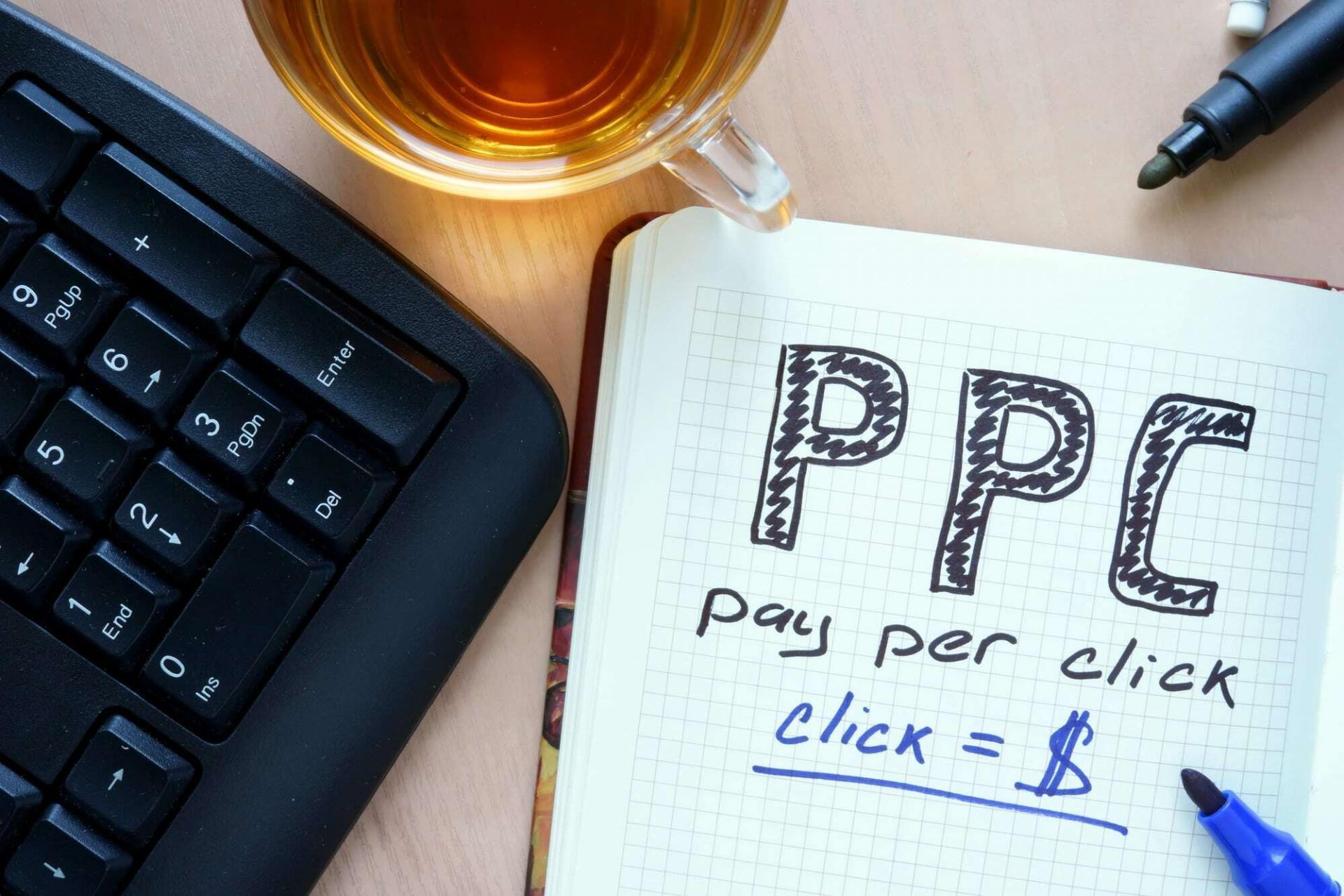Organic traffic isn’t the only way to improve conversions.
It’s becoming increasingly difficult to compete for organic ranking with larger industry and local leaders. If you can’t crack the first page, mainly the top three, then you’re not getting much organic search traffic.
Fortunately, you’ve got options. Take a few minutes and read through our pay-per-click (PPC) guide to discover how to attract your share of buyers.
You’ll find answers to these questions:
- What is PPC advertising?
- What are some common PPC terms?
- Which sites offer PPC advertising?
- What are search and display ads?
- What is keyword research?
- How do you use match types?
- What is targeting?
- What is PPC ad copy?
- What is conversion rate optimization?
- What is off-site remarketing and on-site retargeting?
- Where can you find help?
What Is PPC?
Pay-per-click advertising is a highly-effective tool that attracts better-converting traffic to predetermined landing pages. PPC works best combined with conversion rate optimization (CRO) and strong copywriting skills.
PPC advertising involves keyword research and lead-targeting to generate search and display ads that deliver qualified traffic. A landing page, specially designed for these leads, finishes the job.
PPC advertising differs from more traditional advertising: there’s no cost for impressions. You only pay when views lead to a click.
Successful PPC campaigns:
- Attract new customers
- Contribute to the sales funnel
- Improve conversion rates
- Grow brand awareness
PPC Guide Common Terms
Some terms you should become familiar with include:
- AdWords: Google’s free PPC campaign tool.
- Bid: the amount that you’re willing to pay for a click from specific keywords or phrases.
- Cost per click (CPC): Google calculates CPC using your bid and other factors like competition and landing-page quality. It’s the price you pay when searchers click your ad. It won’t exceed your bid.
- Click through rate (CTR): the percentage of all viewers that click your ad.
- Conversion Rate: describes the percentage of viewers that clicked your ad and also completed a predetermined action on your page. For example, making a purchase, downloading a white paper or completing a form.
- Display network: a collection of over 2 million Google-trusted sites that host display ads.
Sites That Offer PPC
Google is the big dog when it comes to PPC, but other sites provide options, too.
Bing supports PPC advertising and includes Microsoft and Yahoo! sites in its advertising network. Even social media sites like Facebook and LinkedIn have PPC capabilities.
What Are The Two Main Types Of PPC Advertising?
There are two types of PPC advertising. You should familiarize yourself with both.
They are:
- Search advertising
- Display network advertising
Search Advertising
Search advertising targets users who enter specific search terms and fit a defined geographic and demographic profile.
For example, a Ford dealership in Tampa would be very interested in searches that include the words new Mustang Tampa. They’d also be interested in searches for 2018 Mustang MSRP if the searcher is within their area.
Search advertising allows a merchant to present predetermined, customized ads for different search possibilities. The ads lead to landing pages specifically designed to convert clicks into customers or leads.
Search ads typically look like organic search results at the top and bottom of the SERP. They have a small tag that identifies them as ads. You can create ads with extensions such as:
- Call buttons
- Additional page links
- Extra text
- Location information
Call buttons and location information are excellent tools for local businesses, particularly in the service sectors.
Search advertising results vary by industry, but, on average, produce a two or three percent CTR. When combined with a landing page that converts at least 10 percent of traffic, search ads become an impactful way to drive qualified leads into your sales funnel.
Display Ads And The Display Network
Google’s display network includes over 2 million trusted websites that reach approximately 90 percent of internet users. It includes sites like:
- Gmail
- Blogger
- Google Finance
- YouTube
Display ads allow you to reach potential buyers browsing relevant websites, whose profiles indicate that they’re within the buying journey.
Their CTR is lower than search ads, as is their cost. They aren’t as effective as search ads in conversion but hold a high value due to their ability to:
- Grow brand awareness
- Retarget traffic that has bounced off your page
- Provide leads for the top of your sales funnel
Just like search ads, display ads won’t cost anything unless a viewer clicks and visits your landing page.
Keyword Research
Some things never change. Keyword research is still the heart and soul of a robust AdWords or PPC campaign. Keyword research is critical as it impacts:
- Cost per click (CPC). If you cast a net too widely, your ad budget depletes with undesirable clicks.
- Conversion Rate. Keyword research allows you to target high-converting leads while excluding searches that have a lower likelihood of conversion, helping to minimize bounce rate and remarketing costs.
The goal of any campaign is to maximize conversions while keeping the CPC low. Keyword research is one of the most powerful tools available for this purpose. The major PPC platforms include a keyword research tool.
For example, Google’s AdWords includes a Keyword Planner that provides detailed information about any search term including search volume, competition, cost factors and related keywords.
What Are Match Types And How Do You Use Them?
This is important. When bidding on keywords or phrases, you can select a match type. There are four, and they can drastically impact your performance.
Broad Match
This is the default match type, but be careful. Using broad match casts the largest net; triggering your ad for searches that include misspellings and similar words. Synonyms come into play and context of the search isn’t considered. You’ll attract more traffic with broad match, but your conversion rate will likely be low.
Modified Broad Match
Modifiers give better control by limiting Google’s ability to include searches that it deems to be relevant. Adding a plus sign in front of a keyword tells Google to trigger your ad for that specific word and its close variants, but not synonyms or relevant terms.
As an example, if your broad match keyword terms are transmission repair shop, your ad may trigger when a searcher enters automotive body shop. If this does not fit your advertising strategy, change your match type to modified broad match and place a plus sign in front of keywords: +transmission +repair shop.
With this match type, searches for automotive body shop or similar queries won’t trigger your ad. Google will only display your ad if the words transmission and repair, including their plural forms and common misspellings, are searched.
Modified broad match is a good place to start. It allows you to focus efforts on your business’s specific services while reducing low-converting clicks.
Phrase Match
Phrase match respects word order but allows for additional terms.
An ad mapped to the keywords transmission repair shop triggers when a user searches that exact phrase, but it also triggers if a searcher includes more information, such as transmission repair shop in Clearwater.
Be careful with phrase match. In this example, a searcher who enters transmission repair in Clearwater will not see your ad. Using phrase match with long-tailed keywords is a great way to target buyers in the latter stages of the buyer journey, but don’t make the phrases too long or complicated.
Exact Match
Exact match is very restrictive. Your ad only triggers if the search matches your keyword or phrase exactly, and includes no other words.
Use trial and error to determine the best keywords and match types to use with your campaigns. Become familiar with negative keywords to further refine your keyword groups.
Targeting: PPC Sharpshooting
There’s plenty of fish in the sea, but not all fish are equal. Targeting is a vital and valuable PPC skill.
Not only can you tell Google which types of search queries should trigger your ad, you can also include specific geographic, demographic and chronological parameters. It’s especially helpful for local businesses wanting to zero in on ideal customers.
- A searcher that is 100 miles away is less likely to choose your business for their catering needs as one that is 5 miles up the road.
- You wouldn’t want your ad clicked by a searcher looking for a tow truck at 3 a.m. if your service day ends at 5 p.m.
Effective targeting delivers better-qualified leads and reduces the risk that a bad lead clicks your ad.
What Is Conversion Rate Optimization?
It takes two to tango. Ineffective landing pages can derail even the best PPC campaigns.
Skilled PPC advertisers play a game of trial and error. Simple copy decisions, like whether to include the price, can have a sizeable effect on your conversion rate. If you’re confident that your PPC strategy is strong, take the time to analyze and adjust your landing page to increase your conversion rate.
CRO is the process of evaluating and optimizing your landing page to be most effective with your PPC strategy.
Off-Site Remarketing
With, on average, 90 percent of clicks leaving your page without converting, it’s a good idea to have a backup plan.
Off-site remarketing involves tracking your unconverted leads through the display network in an attempt to bring them back to your site. It’s a second-chance tactic that allows you to employ a different approach to regain the visitor and close the sale.
Remarketing is a powerful way to add a few percentage points to your conversion rate.
On-Site Retargeting
Ever move your cursor to close a webpage and notice a large popup appear? That’s on-site retargeting. Though not an inherent part of PPC, it’s a key component to improved conversions.
Using exit-intent technology, your page notices when a visitor is about to leave and employs a last-ditch effort to get a conversion.
Ad Copy
Don’t forget; this is still marketing. Merely putting your ad in front of the right eyes isn’t enough. There is limited character space to work with, especially in a search ad. Follow these best practices:
- Identify your goals by starting with your call to action (CTA)
- Research your competitor’s strategy and improve it
- Determine and state why your product or service is unique
- Create urgency
- Make sure your copy is relevant to the search
Ask For Help
Digital Neighbor believes every business should know how to help themselves in today’s digital marketing world. This PPC guide should get you off on the right foot.
To tackle PPC advertising, practice:
- Keyword research
- Incrementally lowering CPC
- Targeting
- Copywriting
- A/B testing
- Analyzing data
Many businesses choose an external PPC specialist to start, so they can learn the ropes with professionals who create winning strategies. Others don’t have the time to manage the process themselves. We can help.
Whatever your situation, contact us to discuss PPC strategies today.



